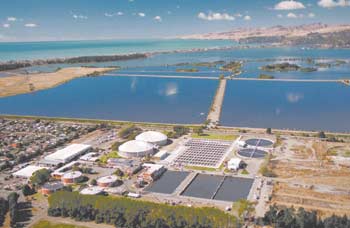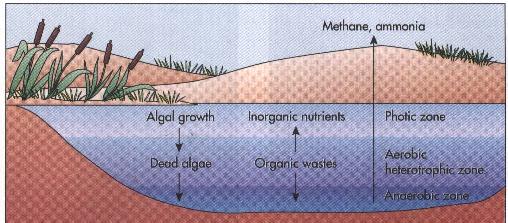Pingpong89 (talk | contribs) mNo edit summary |
(added quote and name to reference) |
||
| Line 5: | Line 5: | ||
== Oxidation as a Process == | == Oxidation as a Process == | ||
Oxidation ponds treat wastewater by either aerobic and/or anaerobic microorganisms (bacteria) contained within a lagoon or pond. Though there are a variety of oxidation ponds all deal with the breakdown of organic matter through biological or physical processes performed by bacteria. They are very popular due to their natural aspects, and the types vary fundamentally because of a few factors, such as, depth, bacteria species, and the amount and composition of wastes.<ref name="Principles of Environmental Engineering and Science">McGraw Hill.</ref> Proper maintenance of these ponds is relatively easy and cost-effective resulting in odorless ponds with no pollutants.<ref name="Lagoons(Oxidation ponds)."> Oklahoma Univ. Printing Services. Retrieved Oct. 28 2008. http://www.deq.state.ok.us/factsheets/local/Lagoon.pdf.</ref> These oxidation ponds are only the secondary step of three in the whole treatment process. First, the water is screened and then streamed through a clarifier, which removes grease and "suspended solids" (substance evenly dispersed with another). The remaining solids from the clarifier are sent through an anaerobic pond to further lower the BOD concentration. This concentration depletes oxygen levels and can lead to a fully anaerobic environment which increases the polluting power of this process. After most of the organic waste has been properly broken down to allow for the desireable BOD concentration it is then sent to the oxidation ponds. The primary process treats about 30 to 40 percent of the wastes and the secondary process removes another 40 to 50 percent.<ref name="Methods of Liquid Waste Treatment. R.M Atlas, Mosby-Year. Principle of Microbiology. Retrieved Oct 26, 2008. http://www.rpi.edu/dept/chem-eng/Biotech-Environ/FUNDAMNT/streem/methods.htm.</ref> | Oxidation ponds treat wastewater by either aerobic and/or anaerobic microorganisms (bacteria) contained within a lagoon or pond. Though there are a variety of oxidation ponds all deal with the breakdown of organic matter through biological or physical processes performed by bacteria. They are very popular due to their natural aspects, and the types vary fundamentally because of a few factors, such as, depth, bacteria species, and the amount and composition of wastes.<ref name="Principles of Environmental Engineering and Science">McGraw Hill.</ref> Proper maintenance of these ponds is relatively easy and cost-effective resulting in odorless ponds with no pollutants.<ref name="Lagoons(Oxidation ponds)."> Oklahoma Univ. Printing Services. Retrieved Oct. 28 2008. http://www.deq.state.ok.us/factsheets/local/Lagoon.pdf.</ref> These oxidation ponds are only the secondary step of three in the whole treatment process. First, the water is screened and then streamed through a clarifier, which removes grease and "suspended solids" (substance evenly dispersed with another). The remaining solids from the clarifier are sent through an anaerobic pond to further lower the BOD concentration. This concentration depletes oxygen levels and can lead to a fully anaerobic environment which increases the polluting power of this process. After most of the organic waste has been properly broken down to allow for the desireable BOD concentration it is then sent to the oxidation ponds. The primary process treats about 30 to 40 percent of the wastes and the secondary process removes another 40 to 50 percent.<ref name="LWT">Methods of Liquid Waste Treatment. R.M Atlas, Mosby-Year. Principle of Microbiology. Retrieved Oct 26, 2008. http://www.rpi.edu/dept/chem-eng/Biotech-Environ/FUNDAMNT/streem/methods.htm.</ref> | ||
== Types of Oxidation Ponds == | == Types of Oxidation Ponds == | ||
| Line 46: | Line 46: | ||
== References == | == References == | ||
<references /> | |||
1. Davis, Mackenzie, and Susan Masten. Principles of Environmental Engineering and Science. McGraw Hill: New York, NY 2004. | 1. Davis, Mackenzie, and Susan Masten. Principles of Environmental Engineering and Science. McGraw Hill: New York, NY 2004. | ||
Revision as of 20:45, 17 November 2008
archived.ccc.govt.nz
Oxidation as a Process
Oxidation ponds treat wastewater by either aerobic and/or anaerobic microorganisms (bacteria) contained within a lagoon or pond. Though there are a variety of oxidation ponds all deal with the breakdown of organic matter through biological or physical processes performed by bacteria. They are very popular due to their natural aspects, and the types vary fundamentally because of a few factors, such as, depth, bacteria species, and the amount and composition of wastes.[1] Proper maintenance of these ponds is relatively easy and cost-effective resulting in odorless ponds with no pollutants.[2] These oxidation ponds are only the secondary step of three in the whole treatment process. First, the water is screened and then streamed through a clarifier, which removes grease and "suspended solids" (substance evenly dispersed with another). The remaining solids from the clarifier are sent through an anaerobic pond to further lower the BOD concentration. This concentration depletes oxygen levels and can lead to a fully anaerobic environment which increases the polluting power of this process. After most of the organic waste has been properly broken down to allow for the desireable BOD concentration it is then sent to the oxidation ponds. The primary process treats about 30 to 40 percent of the wastes and the secondary process removes another 40 to 50 percent.[3]
Types of Oxidation Ponds
Aerobic ponds are only a meter in depth and are filled with aerobic bacteria(Bacillus, cyanobacteria, Nocardia). The shallow water allows for a oxygen rich environment by allowing light to penetrate through entirely to ensure photosynthesis. Aerobic bacteria produce oxygen, which contributes to algal growth and more organic consumption. The aerobic characteristics are essential to the breakdown of organic matter and sustainability of the pond itself.
Anaerobic ponds are lagoons containing mostly anaerobic bacteria(). They are intolerant to oxygen and require that oxygen levels are very low around 0.2ppm. They are greater in depth than aerobic ponds to allow for low light penetration, so that photosynthesis can't be initiated by aerobic microbes. When the ponds are introduced to concentrations of organic matter turbidity(transparency of water) is high contributing to low dissolved oxygen levels along with depths of 10 meters give a suitable environment for these bacteria.
Facultative pond is the combination of both anaerobic and aerobic layers separated by a facultative layer, which are inhabitated by facultative bacteria(Staphylococcus and Escherichia coli). These bacteria have the unique characteristic of being able to live in an environment with or without the presence of oxygen. They are able to derive oxygen from compounds, such as, nitrates, sulfides, and carbonates. During the day these bacteria behave as aerobic bacteria and at night behave as anaerobic bacteria.
Characteristics of Layers
Aerobic bacteria have the ability to consume organic compounds(nutrients) like carbon dioxide, nitrogen, and carbonate are just a few. They are able to remove these compounds at a rate 90 percent faster than anaerobic bacteria.1111 This means that treatment requires 90 percent less aerobic bacteria than anaeobic bacteria, or if you had an equivalent amount the anaerobic bacteria would digest the organic matter 90 percent faster. Also, the anaeobic bacteria release carbon dioxide which can be consumed by aerobic bacteria at near the surface.
Anaerobic ponds consists of lagoons with depths much larger than those of aerobic ponds in order to sustain a large amount of organic waste. These amounts of wastes are necessary to ensure that the oxygen levels stay consistently lower than the "BOD" concentration. "BOD"(Biological Oxygen Demand) is the measurement of organic matter or pollutants within a measured amount of water. The depths of these ponds are much deeper to restrict photosynthesis. These types of bacteria can be classified as going through two stages as they consume organic matter. Acid fermentation is the first stage and what occurs is the breakdown of complex organic molecules into long chains of alcohol and acids. The next stage is called methane fermentation, this is when the alcohols and acids are converted to gaseous methane and carbon dioxide. The ability of these microorganisms to process waste is very dependant on the climate. Differences in weather conditions, such as fog and wind affect the metabolic rates by distributing solids among the ponds ,which would provide too much aeration, and inhibiting sunlight exposure. This can impose danger to the anaerobic bacteria, because of the possibility of oxygen being more readily present.[1]
Facultative Oxidation Ponds (Arcata)
CO2 + H2O + light = algae + O2
organic compounds + O2 = CO2 + H2O
ANAEROBIC ZONE
organic compounds = organic acids (Acid Fermentation)
organic acids = CH4 + CO2 (Methane Fermentation)
Arcata's oxidation ponds are facultative, most popular type. These ponds are used primarily by small communities, but also consist of about 25% of America's municipal wastewater treatment facilities. The process involves first introducing wastewater, which contains "suspended solids."[1] These solids sink to the bottom of the pond to promote an anaerobic layer of bacteria. The level above is called the facultative layer where oxygen s present during the day due to the process of photosynthesis performed by aerobic bacteria, and during the night anaerobic species inhabit this region. Above this layer and at the water surface, aerobic bacteria exist due to the sunlight and presence of oxygen. The oxygen required to sustain life is ultimately coming from the sun, because this light ensures photosynthesis producing oxygen, but what about at night? The source of oxygen is acquired by diffusion across the water surface. This is very important because the pond then can't become anaerobic.
Arcata
Arcata's oxidation ponds were built in 1957 and have not yet been drained. It was separated into two ponds by a dyke in 1986 one is 9.9 hectares and the other is 6.9 hectares.[4]
Oxidation ponds consume the organic waste and produce simple chemical elements and biological gas that contribute to algae production, which furthers the availability of oxygen and hence increasing decomposition. Some of the simple elements made are carbon, nitrogen, and phosphorus for algal bloom.
The anaerobic zone will consume algal solids and organic effluent settlements excreting methane gas. As this process continues and new effluent is being added the pond will reach a focal point, its equilibrium. This point is reached when the matter being released as methane is equal to the amount of effluent entering the system. Oxidation ponds adapt easily to different rates of influent making them ideal in terms of environment and efficiency.[4]
Arcata is equipped with two ponds that while having the same depth(2m), vary in area. The deposition of the variety of solids including volatile and other organic solids, were evenly dispersed between both bodies of water resulting in a uniform mass to volume ratio. Pond one effectively removed 77 percent of organic wastes and pond two consumed about 79 percent. This efficiency was also due to trenches constructed along the walls of the dyke, adding an extra meter in depth to facilitate the growth of large amounts of anaerobic bacteria. The trench sites allow for a large accumulation and compaction of organic solids. These trenches act as an anaerobic digestor within the facultative oxidation pond. After the waste is processed, the water enters a chlorination step where chlorine gas or hypochlorite is added to produce hypochlouric acid.[5] The channel is diverted in two streams either going back through the marshes for further processing, or dechlorinated and released into Humboldt Bay.
References
- ↑ 1.0 1.1 1.2 McGraw Hill.
- ↑ Oklahoma Univ. Printing Services. Retrieved Oct. 28 2008. http://www.deq.state.ok.us/factsheets/local/Lagoon.pdf.
- ↑ Methods of Liquid Waste Treatment. R.M Atlas, Mosby-Year. Principle of Microbiology. Retrieved Oct 26, 2008. http://www.rpi.edu/dept/chem-eng/Biotech-Environ/FUNDAMNT/streem/methods.htm.
- ↑ 4.0 4.1 Logan R Olds. Humboldt State University: Arcata, CA 1996. Cite error: Invalid
<ref>tag; name "Solids Accumulation within the City of Arcata's Facultative Oxidation Ponds." defined multiple times with different content - ↑ R.M Atlas, Mosby-Year. Principle of Microbiology. Retrieved Oct 26, 2008. http://www.rpi.edu/dept/chem-eng/Biotech-Environ/FUNDAMNT/streem/methods.htm.
1. Davis, Mackenzie, and Susan Masten. Principles of Environmental Engineering and Science. McGraw Hill: New York, NY 2004.
2.Lagoons(Oxidation ponds). Oklahoma Univ. Printing Services. Retrieved Oct. 28 2008. http://www.deq.state.ok.us/factsheets/local/Lagoon.pdf
3. Solids Accumulation within the City of Arcata's Facultative Oxidation Ponds. Logan R Olds.Humboldt State University: Arcata, CA 1996.
4. Methods of Liquid Waste Treatment. R.M Atlas, Mosby-Year. Principle of Microbiology. Retrieved Oct 26, 2008. http://www.rpi.edu/dept/chem-eng/Biotech-Environ/FUNDAMNT/streem/methods.htm
www.norweco.com/html/lab/Identify.htm

